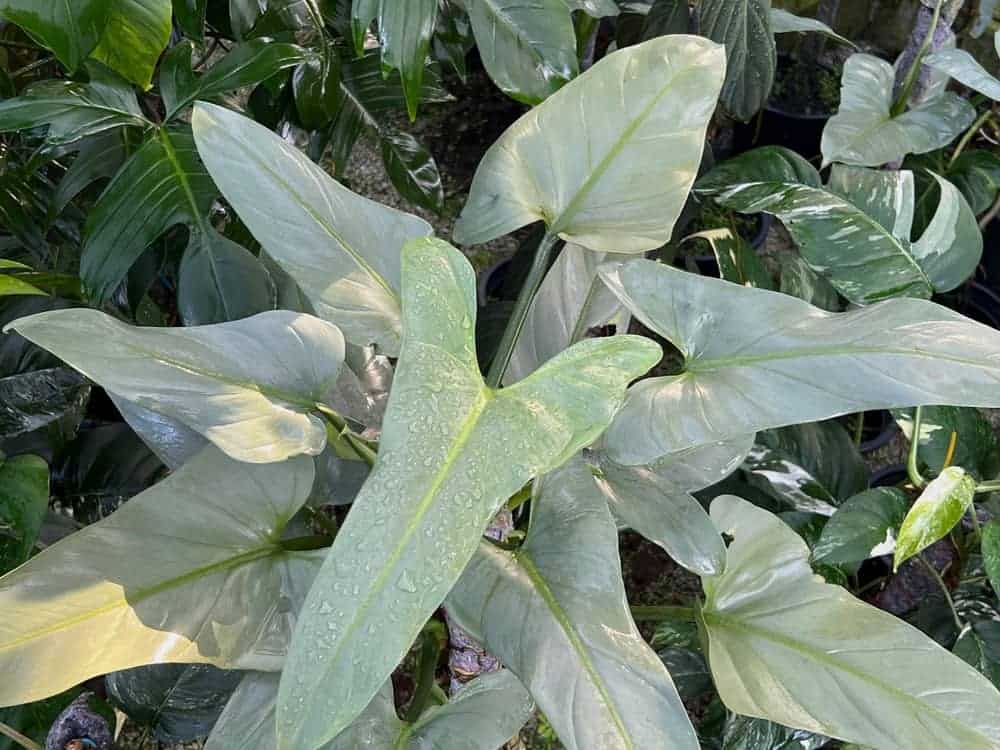On the lookout for a subtly elegant philodendron variety? Consider the silver sword philodendron.
You’ll love the understated beauty of its silvery-blue-toned leaves shaped like the blade of a sword. However, keep in mind that this variety isn’t as low-maintenance as other philodendrons!
Silver sword plants need consistently moist soil and plenty of bright, indirect sunlight, plus moderate (at least!) humidity. Combine that with a free-draining potting mix and your plant should thrive.
Just as a loyal knight maintains their weapon, your philodendron silver sword will shine with proper care. That way, it’ll stand out even in your army of plants!
Potting Mix | Light | Temperature and Humidity | Watering | Supports | General Care | Propagation | Common Problems
Attention, Silver Sword Philodendron!
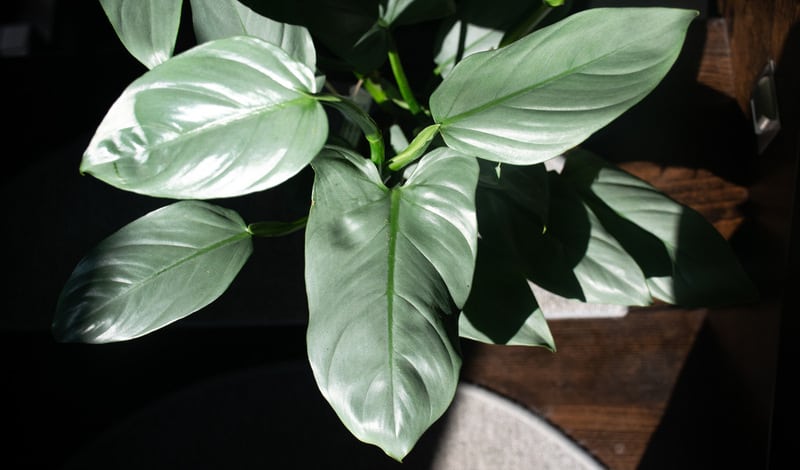
No prizes for guessing where the name comes from! The Philodendron hastatum ‘Silver Sword’ is loved for the silvery shimmer on its sword-shaped leaves.
That silver tone is less pronounced when the plant is younger. As it matures, you’ll see more of a silvery-blue with leaves that grow longer and pointier.
Silver sword philodendrons are evergreen plants native to the tropical rainforests of South America. In their natural habitat, they grow in warm temperatures, humid climates, and dappled light.
Like other types of philodendrons, Philodendron hastatum is toxic to humans and pets (such as cats and dogs). It can cause gastrointestinal issues when chewed, licked, or ingested.
Ideal Growing Conditions for Silver Sword Philodendrons
When it comes to setting up your plant, Philodendron hastatum will thrive in conditions that mimic its native environment.
That means giving it enough light, humidity, and soil drainage!
Potting mix
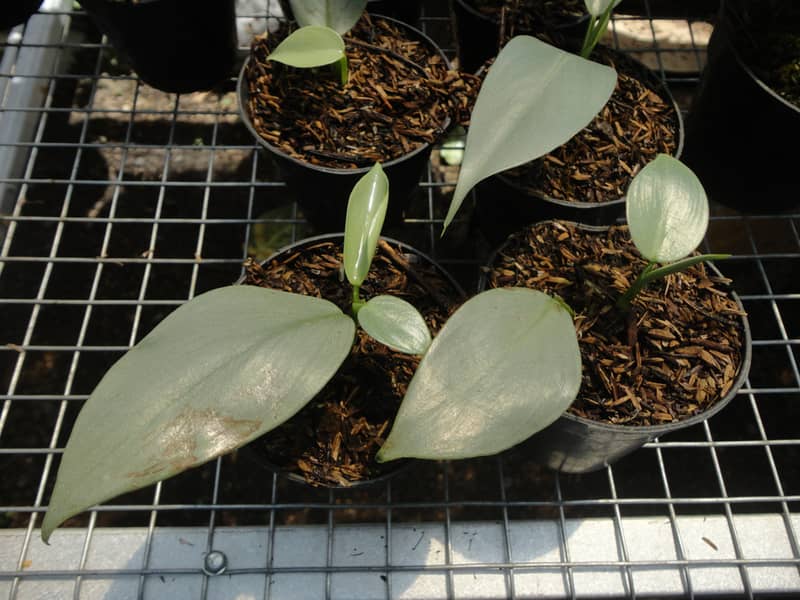
Like other aroids, your silver sword philodendron will thrive in chunky, well-drained soil. Look for potting mix specifically for aroids or amend regular houseplant mix with perlite, coir, and bark.
You want airy soil that retains moisture while allowing good drainage. Avoid anything with clay, which can compact or retain too much water and suffocate the roots.
Make sure the pot has plenty of drainage holes as well! This helps prevent the soil from becoming soggy.
Light requirements
To maintain that signature silver sheen, your silver sword philodendron needs lots of bright, indirect light — near an east/northeast-facing window with 6 hours of sun or underneath a full-spectrum grow light.
Avoid exposure to direct sunlight, especially in the afternoon, as it can scorch the pale leaves.
On the other hand, if you notice leggy growth and leaves that are more green than silver, your plant is getting too little light! Move it closer to the window or consider a grow light.
Temperature and humidity
Similar to other philodendrons, normal household temps between 18º–30ºC should be fine.
Philodendron hastatum can tolerate more moderate humidity levels (at least 40%) but prefers high humidity — around 60% or higher. After all, it’s a tropical plant native to rainforests!
To raise humidity, you can group plants together to increase humidity or use a humidifier. However, pebble trays and misting aren’t very helpful.
Avoid any extreme temperature fluctuations or cold drafts — no vents or air-conditioning nearby!
How to Care for a Silver Sword Philodendron
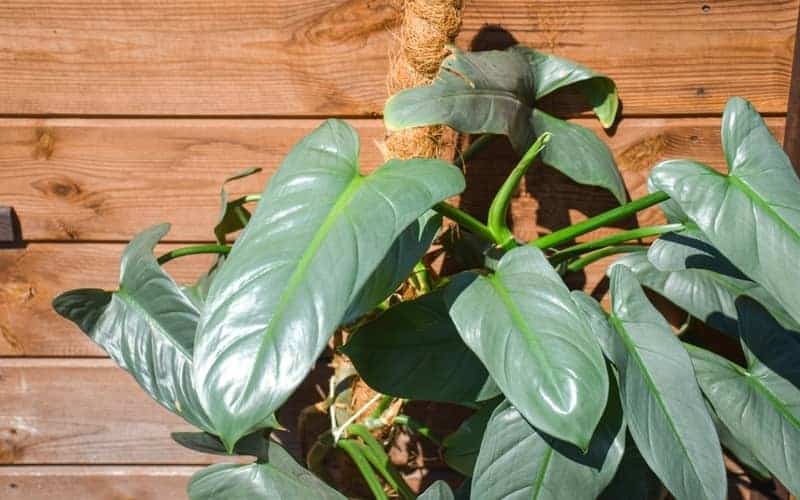
Proper care is essential for a healthy and happy Philodendron hastatum! Your main concern will be watering and providing good plant support.
Watering
This is one of the trickier parts of silver sword philodendron care. Your plant will be happiest when you keep the soil moist but not waterlogged.
However, Philodendron hastatum is susceptible to both overwatering (root rot) and underwatering.
As a general rule, water the plant when the soil is about 1/4 to halfway dry. Use your finger or a wooden stick to test moisture levels, or keep the plant in a clear pot so you can see the soil.
Adjust your watering based on the plant’s environment! If it’s sunny or hot, you may need to water more often, then scale back in the cooler winter months.
Avoid letting the plant dry out completely, or the foliage can become damaged.
If you notice drooping and dry leaves, your plant is underwatered. Place the pot in a container with water halfway up the side, and give it a good soak.
Let the excess water drain afterwards.
Plant supports
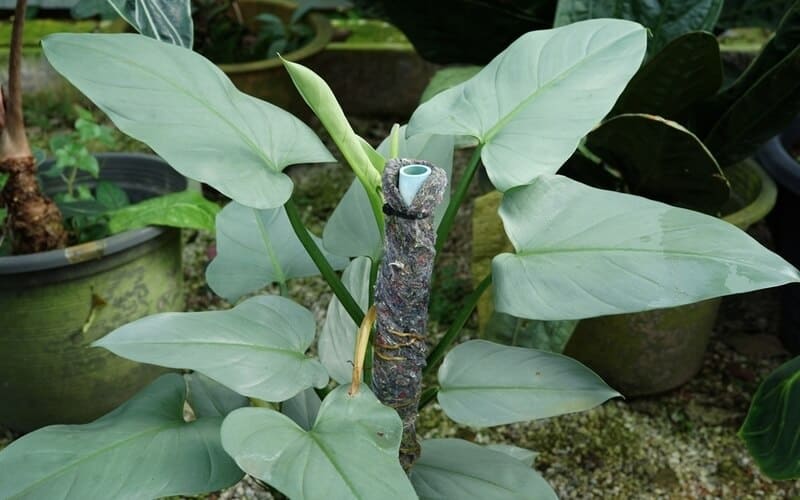
The philodendron silver sword is a climber in its natural habitat, so give it a support to climb indoors! Look for moss poles, stackable coir poles, or plant stakes.
Attach the plant to its support using gardening clips or jute string. Position the attachment between leaf nodes or petioles.
You can let the silver sword plant trail out of a hanging basket, but you may see leggy growth or balding as the stems get longer.
General plant care
Besides maintaining good moisture and humidity levels, the Philodendron hastatum isn’t too fussy!
Plant food isn’t strictly necessary, but your silver sword will appreciate a balanced liquid fertiliser during the growing season. Dilute it to half strength and fertilise every 4–5 weeks.
Reduce or skip the fertiliser during cool or rainy periods.
You should only need to prune your silver sword plant if you notice unhealthy or leggy growth, or if the plant is getting unruly. These plants are fast growers, so seasonal trimming can maintain a good size.
When pruning, count 3–4 leaf nodes above the soil level, then cut the affected stem between nodes.
If you have diseased or dying leaves, remove them ASAP. However, yellowing foliage at the bottom is a natural part of the plant’s life cycle — you can leave the leaves (ha) to drop naturally!
Repot your Philodendron hastatum when it becomes rootbound. Look for roots circling the base of the pot or poking out of holes, and slowed growth.
Choose a pot 3–5cm bigger than the current container to avoid suffocating or waterlogging the plant.
Philodendron Silver Sword Propagation
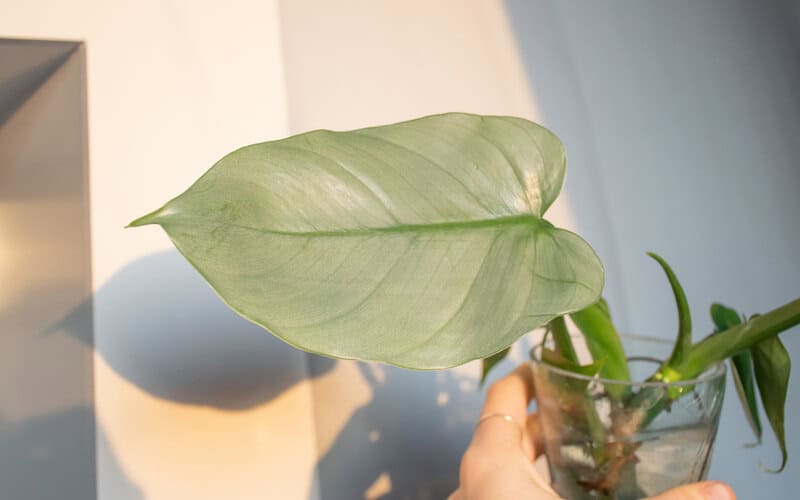
Good news — you can easily propagate a silver sword philodendron from stem cuttings!
Choose a healthy stem with at least 2–3 mature leaves and leaf nodes (or aerial roots). Measure 5–10cm from the tip, then cut between two nodes.
Remove any leaves from the bottom half of the stem, then place it in a clear jar. Pour enough water to cover at least one node — but without touching any leaves.
Place the cuttings in a warm, bright location. You can change the water if it becomes murky or starts growing algae, but otherwise, just top up as needed.
You should start seeing new roots in 2–6 weeks. Wait until they’re 4–6cm long with secondary roots, then transfer the cuttings to a small pot with free-draining potting mix.
Keep the soil moist for a few weeks as the plant transitions and establishes itself.
Philodendron Silver Sword Common Problems
Philodendrons are pretty resilient houseplants, but you may still face some issues — especially with watering or pests.
Yellowing leaves
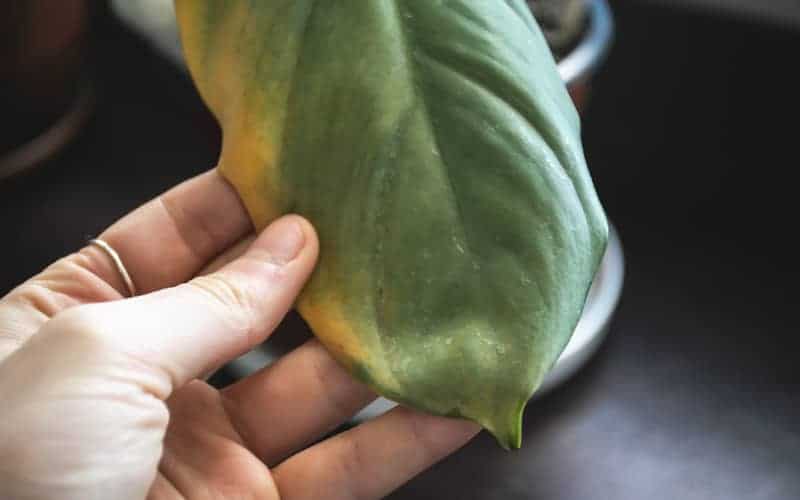
Yellow, drooping leaves are often a sign of overwatering and root rot.
While silver sword philodendrons prefer consistent moisture, waterlogged soil can suffocate and rot the roots. Too-frequent watering, poor drainage, and dense soils can all cause rot.
Check underneath the soil immediately. A healthy root system is white and firm, so if any are dark-coloured, mushy, or stink, that’s a sign of rot.
If there are some healthy roots left, cut off all the rotted ones and spray the rest with a little 3% hydrogen peroxide. Repot the plant in fresh soil ASAP and hold off watering for a few days.
Brown leaves
Brown, crispy foliage can be a symptom of either underwatering or leaf burn.
Check if your silver sword plant sits in direct sunlight, especially in the afternoon. If yes, remove the dry leaves and move the plant away so it’s not as exposed.
For underwatering, give the soil a long soak by bottom watering. This helps thoroughly rehydrate the soil and allows the plant to absorb as much water as it needs.
Leaf spot
If your silver sword’s leaves have dark spots with a yellow outline, it may have leaf spot!
This is a fungal or bacterial infection that affects the leaves of plants. Most leaf spot is caused by fungi, but some infections come from bacterial growth or plant viruses.
Besides the dark blotches, some signs of leaf spot include:
- Excessive leaf drop
- Holes or lesions on leaves
- Stunted or distorted growth
You’ll need to prune off all affected leaves and stems ASAP. Ensure the plants have good air circulation and avoid wetting the leaves/stems when watering.
For severe disease, use a copper-based bactericide or fungicide. Follow the product instructions carefully!
Pests
Like other indoor plants, the silver sword is susceptible to common pests like:
- Aphids
- Mealybugs
- Spider mites
- Thrips
After identifying the pests, you can get rid of them by spraying the plant with either insecticidal soap or diluted neem oil.
For small infestations, wipe off the insects with a cotton bud dipped in rubbing alcohol.
Say More: FAQs About Silver Sword Plant Care
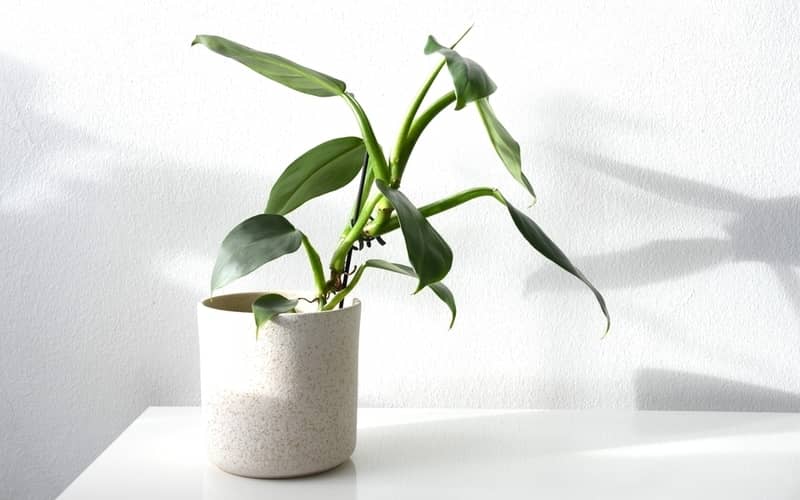
We’ve rounded up a few more questions and concerns people have about caring for silver sword philodendrons here.
Is the philodendron silver sword rare?
Philodendron silver sword plants used to be much rarer, but they’re more common now thanks to cultivation!
What is rare is the variegated silver sword, which has splashes of cream or yellow on the silvery leaves.
If you get your hands on one, keep in mind that the variegation may revert in new growth as it’s quite unstable.
Is the philodendron silver sword hard to care for?
Silver sword plants are fussier than low-maintenance types like the heartleaf philodendron.
They need soil that’s consistently moist and moderate to high humidity levels, plus a good amount of bright, indirect sunlight. You’ll need to be careful not to over- or underwater the plant, too.
How big does the Philo silver sword get?
In ideal conditions, your philodendron silver sword can get pretty big — up to 4.5m in length and 0.6m wide indoors.
Giving the plant proper support and adequate light will encourage lush, healthy growth. Seasonal pruning can also encourage a bushier appearance!
Does the philodendron silver sword need a moss pole?
A moss pole is a great support for your silver sword plant, but it’s not the only one you can use! Coco coir poles, plant stakes, and stackable plastic poles also work well.
Giving your climbing silver sword a support will ensure a healthy, happy plant with bigger leaves and fuller growth!

